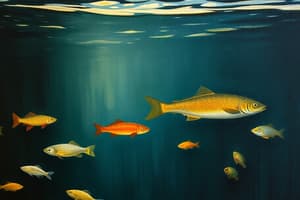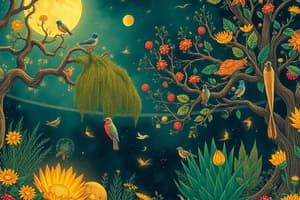Podcast
Questions and Answers
Which statement accurately describes a food chain?
Which statement accurately describes a food chain?
- It includes only herbivores and carnivores.
- It is a sequence of organisms where one eats another to gain energy. (correct)
- It represents a circle of life with no beginning or end.
- It consists solely of producers like plants.
Which of the following is the first link in every food chain?
Which of the following is the first link in every food chain?
- Decomposers
- Producers (correct)
- Carnivores
- Herbivores
What happens to a food chain when one link is removed?
What happens to a food chain when one link is removed?
- The food chain will continue unaffected.
- The entire food chain will be disrupted. (correct)
- The food chain becomes stronger.
- Only the remaining links are affected minimally.
What is bioaccumulation?
What is bioaccumulation?
Which type of chemicals can contaminate food chains?
Which type of chemicals can contaminate food chains?
What role do producers play in a food chain?
What role do producers play in a food chain?
How do pollutants like pesticides affect the food chain?
How do pollutants like pesticides affect the food chain?
What is the main consequence of overgrazing?
What is the main consequence of overgrazing?
What is the primary role of predators in an ecosystem?
What is the primary role of predators in an ecosystem?
Which of the following best describes a food web?
Which of the following best describes a food web?
Which type of material cannot be easily broken down by microorganisms?
Which type of material cannot be easily broken down by microorganisms?
How do omnivores impact food chains?
How do omnivores impact food chains?
What might happen if all lions disappeared from an ecosystem?
What might happen if all lions disappeared from an ecosystem?
What causes land pollution?
What causes land pollution?
Which of the following examples includes biodegradable materials?
Which of the following examples includes biodegradable materials?
What is the primary effect of excessive use of fertilizers and pesticides?
What is the primary effect of excessive use of fertilizers and pesticides?
What effect do CFCs have on the environment?
What effect do CFCs have on the environment?
What is the discharge of water waste primarily concerned with?
What is the discharge of water waste primarily concerned with?
Which of the following actions contributes to water pollution?
Which of the following actions contributes to water pollution?
What does the term 'overfishing' refer to?
What does the term 'overfishing' refer to?
Which of the following best describes the impact of industrial waste on water bodies?
Which of the following best describes the impact of industrial waste on water bodies?
What primary activity contributes to land pollution by affecting soil quality?
What primary activity contributes to land pollution by affecting soil quality?
What is a direct consequence of throwing garbage into piles?
What is a direct consequence of throwing garbage into piles?
Which of the following is NOT a cause of air pollution?
Which of the following is NOT a cause of air pollution?
What phenomenon is primarily caused by the burning of coal and fuel?
What phenomenon is primarily caused by the burning of coal and fuel?
What is a major effect of land pollution on plant life?
What is a major effect of land pollution on plant life?
Which gas is primarily emitted from air conditioning systems and refrigerators?
Which gas is primarily emitted from air conditioning systems and refrigerators?
What can happen if the ozone layer is depleted?
What can happen if the ozone layer is depleted?
What health issue can result from breathing polluted air?
What health issue can result from breathing polluted air?
Flashcards are hidden until you start studying
Study Notes
Food Chains and Food Webs
- All living organisms depend on each other for food
- Food provides energy for growth and life processes.
What is a Food Chain?
- A sequence showing how energy flows through an ecosystem by who eats whom.
- Each organism is essential for the chain's survival.
Example of a Food Chain
- Grasshopper eats grass.
- Frog eats the grasshopper.
- Snake eats the frog.
- Eagle eats the snake.
- Energy and nutrients are transferred from one organism to the next in the chain.
Links in a Food Chain
- Every organism forms a link in the food chain.
- Plants are producers and the first link in the chain.
- Removing a link disrupts the entire food chain.
Toxins and Food Chains
- Environmental contamination can lead to pollutants entering the food chain through plants and animals.
- For instance, fish absorbing contaminated water become contaminated.
- Consuming contaminated fish transfers toxins to the next organism in the chain.
What is a Toxin?
- Substances like fertilizers, pesticides, and insecticides can contaminate soil and water.
- Producers absorb these contaminants, transferring them to the next link in the chain.
- Toxins build up in animal fat and tissues through bioaccumulation.
- Top predators have the highest concentration of toxins due to the accumulation process.
What is Bioaccumulation?
- The process of toxins accumulating in animal fat and tissues.
Deforestation
- Large-scale tree cutting.
- Industries release harmful substances like smoke, dust, and gases into the air.
Overgrazing
- Excessive grazing destroys grasses, shrubs, and plants.
Polluted Water
- Hazardous chemicals and substances are discharged into rivers and streams.
Excessive use of Fertilizers and Pesticides
- Runoff into water bodies causes pollution.
Predators and Prey
- A predator hunts and eats prey animals.
- Examples of predators: Lions, owls, cheetahs.
- Examples of prey: Deer, mice, grasshoppers.
Interactions Between Predators and Prey
- Animals interact in ecosystems by using each other as food sources.
Omnivores
- Organisms that consume both plants and animals.
- Omnivores significantly impact food chains.
- Examples: Bears, birds, dogs, raccoons, foxes, some insects, and humans.
Food Webs
- A network of interconnected food chains in an ecosystem.
- Represents the complex relationships between organisms.
- Energy and nutrients flow through the web.
Human Activities and the Ecosystem
- Humans alter the environment, potentially disrupting the balance of ecosystems.
Biodegradable and Non-Biodegradable Materials
- Items we use lose functionality and become garbage.
- Garbage can be classified as biodegradable or non-biodegradable.
Biodegradable Materials
- Decomposed by microorganisms in nature.
- Examples: Animal waste, tea leaves, vegetable peels, leftover food, waste paper, wood items.
Non-Biodegradable Materials
- Cannot be easily broken down by nature.
- Examples: Metal, tin, glass, plastics.
- Persist in the environment for centuries, causing pollution.
Land Pollution
- Harmful substances in soil degrade soil quality.
Causes of Land Pollution
- Deforestation: Reduces soil quality and fertility.
- Use of plastics and chemicals: Solid waste (cans, plastic bottles) and chemicals (pesticides, fertilizers) pollute soil.
- Industrial waste: Waste from industries.
Effects of Land Pollution
- Garbage dumps attract disease-carrying organisms.
- Soil erosion: Loss of fertile topsoil due to loose soil.
- Polluted soil affects plant growth, leading to unfit produce for consumption.
Air Pollution
- Introduction of harmful gases and particles into the air.
Causes of Air Pollution
- Burning of fuels: Coal, petrol, and diesel release poisonous gases.
- Smoke from factories: Factory emissions release harmful gases.
- Volcanic eruptions: Release ash and gases into the air.
- Burning of firecrackers: Releases pollutants into the air.
Effects of Air Pollution
- Polluted air harms lung health, leading to respiratory problems like asthma.
Smog
- A type of air pollution that reduces visibility.
- Common in industrial areas, especially during winters.
Ozone Layer
- Protects Earth from harmful ultraviolet radiation from the Sun.
Chlorofluorocarbons (CFCs)
- Gases released from air conditioners and refrigerators.
- Damage the ozone layer, exposing us to harmful UV rays.
Water Pollution
- Contamination of water bodies by household, agricultural, and industrial waste.
Discharge of Water Waste
- Releasing wastewater into water bodies.
Causes of Water Pollution
- Throwing garbage into water.
- Washing and bathing near water bodies.
- Discharge of untreated industrial waste.
Vocabulary
- Fertilizer: Substance for soil nutrient enhancement.
- Overhunting: Hunting leading to population decline.
- Overfishing: Excessive fish catching causing population depletion.
- Famine: Food scarcity.
- Drought: Water shortage due to lack of rain.
- Global: Worldwide.
- Submerge: Underwater.
- Volcanic Eruption: Volcanic release of lava, ash, and gases.
- Breeding: Reproducing.
- Fertile: Capable of producing abundant crops.
Studying That Suits You
Use AI to generate personalized quizzes and flashcards to suit your learning preferences.




